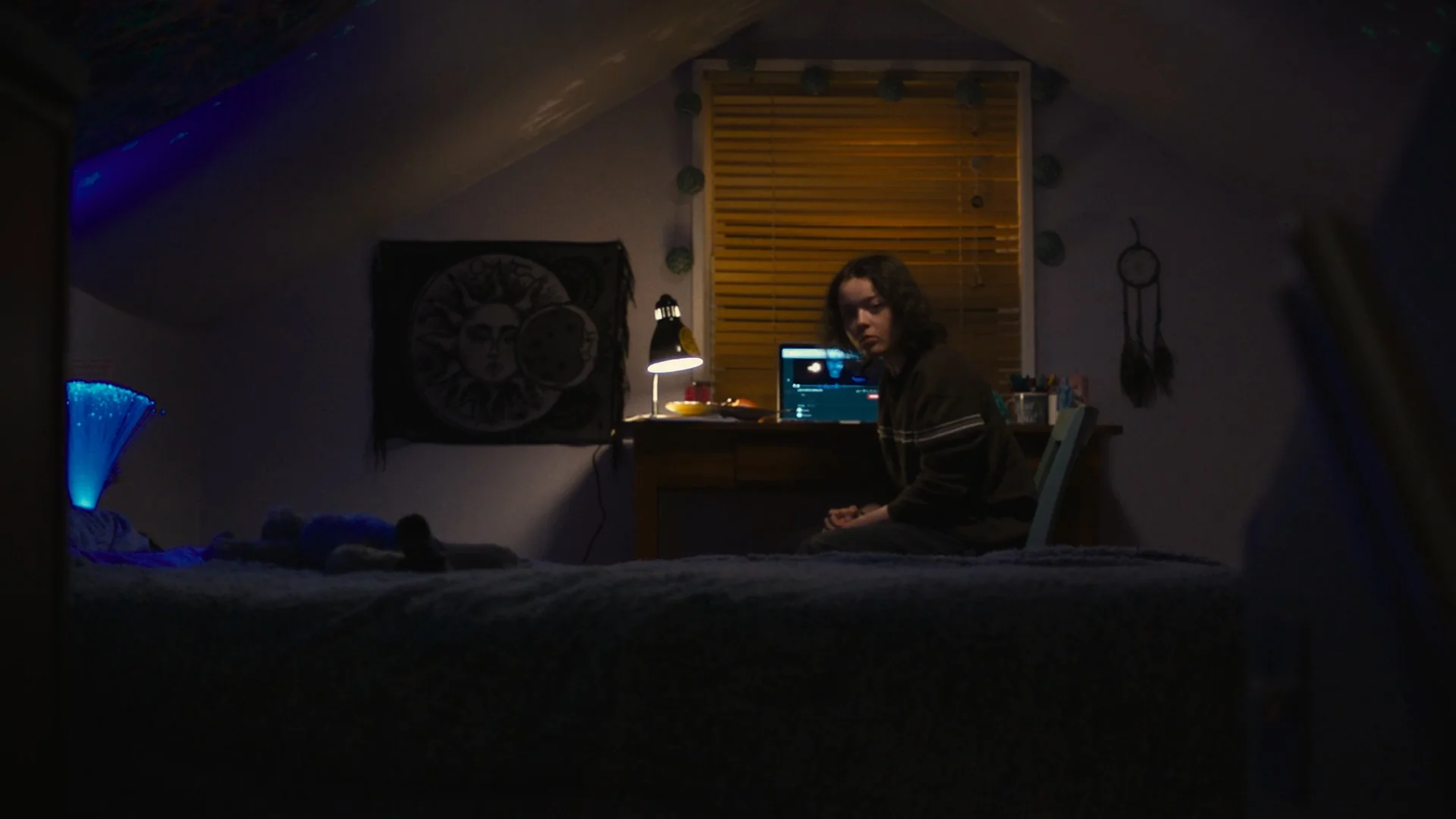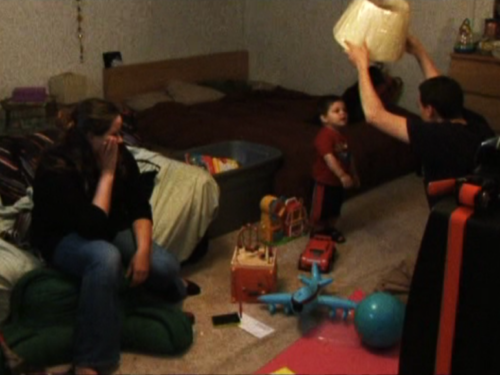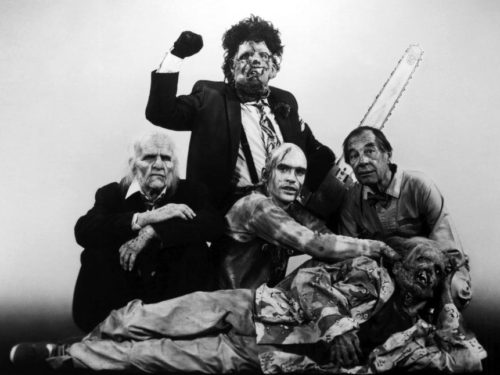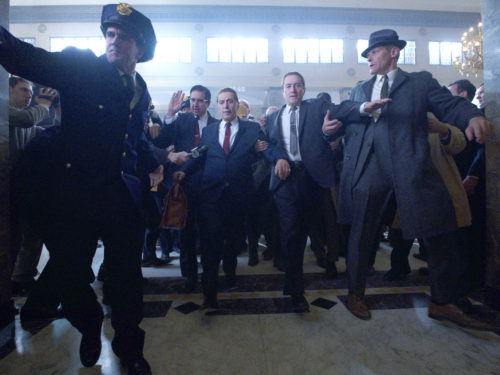An early standout of the 2020s, We’re All Going to the World’s Fair is an exploration of escape and transformation
Floating atop viewer expectations, We’re All Going to the World’s Fair turns ingrained, standard viewing habits against its audience to explore something profoundly greater. The film is like quicksand: the deeper you go, the harder it is to step out and give a cursory synopsis. The official synopsis goes as follows: “Alone in her attic bedroom, teenager Casey becomes immersed in an online role-playing horror game, wherein she begins to document the changes that may or may not be happening to her.” I can’t argue with this. It’s a starting point. Again, though, we take note of the film’s self-awareness. The filmmaker, Jane Schoenbrun, is aware of how such a synopsis will affect viewers’ experience with the film. It sounds like an enticing horror film, right? The film’s tone builds upon itself like the best arthouse horror: nods to Haneke, Cronenberg, Kiyoshi Kurosawa, and even a dash of teenage cosmic mysticism, like the cinematic offspring of Benny’s Video (1992) and Donnie Darko (2001). We’re on edge because we think we know what’s coming. We’re primed to expect that Hanekian act of violence around each corner. Far from an act of audience deception, the chasm World’s Fair creates between expectation and experience provides a hypnotic, multi-layered contemplation of storytelling, connection, and escape.
The film begins with Casey (Anna Cobb) eating string cheese and staring into her computer screen as she prepares to dive into the World’s Fair, an online horror challenge. Her room is lit by blacklights, stars glowing green across her vaulted ceiling. We, the audience, take the point of view of Casey’s laptop, though it would be more precise to point out that we are not viewing Casey through the literal lens of her webcam. The image we see comes from a static, formalist place, the digital cinema camera of the filmmakers. Throughout the film we experience a mix of forms: the filmmakers’ camera, the webcam of Casey’s laptop, the camera on Casey’s phone, or a screen capture of the videos she watches online. With the mix of formats, this isn’t your standard screenlife film, despite its repeated use as a framing device. The screenlife and screenlife-adjacent approaches find their impact through contrast and expectation. When we leap from the confines of either side of the computer or phone screen, such as when we follow Casey through the suburban wilderness or, unnervingly, through the town’s Main Street on New Year’s Eve, we are thrust into the physical world, a contrast from the pixel-based structuring of a screen, a cyber deus ex machina unleashed from the internet and made flesh in the suburban world.
Casey takes the challenge, reciting “I want to go to the World’s Fair” three times before pricking her finger, rubbing her blood on the laptop screen, and watching a strobing, hypnotic video accompanied by a sub-bassy, droning soundtrack. (In my pre-internet, elementary school days it was repeating “Bloody Mary” in the mirror three times.) She tells her online audience that she’ll update them if she notices any changes. This “challenge” becomes our introduction to a role-playing horror game, kind of like Dungeons & Dragons fused with the uncanny terror of a creepypasta story with players/storytellers spread over the internet. Throughout the film we’ll see other “players” act out their transformations, some going numb, others turning plastic, all as a way to recount and act out their own twist on the World’s Fair horror concept.

Schoenbrun locates the devil in the details, particularly when it comes to Casey’s relationship with her father. Casey’s bedroom is in an attic, with its sloped walls and storage clutter. It’s as if she were an inconvenient, last-minute addition to the household, the attic storage pushed to the side to make room for bed, desk, and daughter. Later, Casey explores videos from fellow World’s Fair Challenge participants, watching on her phone as she eats dinner alone in a darkened dining room. Headlights pull up, and Casey scurries away. She sits at her attic bedroom desk with her dinner plate as footsteps trudge through the house. As we’ll come to find later, this is likely her father, an overbearing presence that casts a long shadow over Casey’s teenage existence. Later that night, Casey watches more videos of her fellow World’s Fair Challengers, and her father bangs violently on the ceiling, “It’s three o’clock in the fucking morning!” Casey apologizes, recedes into herself. We’re beginning to understand Casey’s need to transform, to escape herself and her surroundings.
The film’s opening titles showcase a dismal array of geriatric suburban capitalism. Like most of the outdoor shots, these are all shot handheld. Empty strip malls, parking lots covered in dirty snow, decrepit big-box stores succumbing to internet convenience and variety, a long forgotten Toys “R” Us: what was once a vibrant staple of booming suburbia in the 1990s is now a winter wasteland. Signs of a crumbling empire that has receded into the reaches of cyberspace foreshadow a physical disconnection in Casey’s life. Presumably cut off from friends (we don’t see Casey interact with anyone in person), and from people in general (she later apologizes for not being good at talking to people), Casey finds community online, seemingly taking the World’s Fair challenge as a way to connect with others. Without friends or family (well, a distant and potentially abusive father), she is lured by the promise of transformation.

In a pivotal scene, Casey comforts herself one evening in a barn on her property. In one long take, Casey first sets up the laptop to record herself sleeping in bed. Frustrated by the stupidity of the situation, she bundles herself, grabs Poe, her stuffed animal sloth, grabs a lantern, and escapes to the backyard barn. There’s a brief moment where Casey pulls out her father’s AR-15-style hunting rifle. She returns the gun to its hiding place and settles in to watch a soothing ASMR video projected upon the barn wall. Throughout much of the film we repeatedly encounter a loading screen: two arrows circling counterclockwise as a new video loads. This visual motif is presumably an analogue to autoplay features on YouTube, delivering a steady stream of videos chosen by The Algorithm for a specific user. Here in the shed, the ASMR video gives way to a new video, “A Message for Casey from JLB.” There is a photoshopped image of Casey, warped and frightening. The eyes go black, downpitched laughter fills the video soundtrack. Messages flash onscreen: “You are in trouble” and “I need to talk to you.” The horror is palpable. Who sent this video? What does it mean? Casey walks up to the projected video, and we’re caught off guard as Alex G’s music sets a new tone, steering us away from the atmosphere of horror. The scene in the barn dissolves to a winter forest, our horror expectations again defied.
Casey strikes up an online relationship with JLB, who appears to be an imaginative adventurer in the online realms of horror RPG, MMORPG, creepypasta, and more. Though we expect JLB to be an evil figure shrouded in the shadowy darkness of the internet, he’s actually a lonely, middle-aged man living in an affluent suburban home. He’s surrounded by childhood dolls and trophies. He drinks warm milk, likes to draw scary faces, and seems to live with his mother. He’s Casey’s existential doppelgänger, both lonely, disaffected children seeking escape and transformation, locked in a decaying suburban existence void of magic. Repeatedly we see them both attached to screens as a means for escape, lying on the bed watching World’s Fair videos, glued to videos on their phones, aching for connection but also yearning for some kind of escape. Casey finds a kindred spirit in JLB, a friend, even a father figure. And for JLB, Casey is a fellow traveler, someone to care for. They each are able to fill the other’s void.
But, in the end, escape and transformation are not always compatible with connection and family. Our friends and family may only know one side of us, unaware of the vast humanity we keep locked inside or present to others. The fractured narrative and internet/DIY aesthetic exemplify this. Over the course of her journey, Casey embraces the game as she pushes her videos to greater extremes of morbidity, a reflection of her transformation. At first, JLB encourages her. He narrates a video of Casey sleeping, where halfway through she slides to the edge of the bed, her face contorting into a demonic smile. JLB pauses the video. He references Paranormal Activity (its second reference in the film). In a more traditional horror film, yes, this scene would be the goosebumpy tentpole, the squirming, groan-inducing moment of terror. The scene is certainly terrifying, but we’re watching it like a screenlife film, which gives us an added level of remove which serves to intellectualize the horror. JLB’s cursor stops the video, and he comments on the horror. He tells her to keep making videos so that he knows she’s OK.
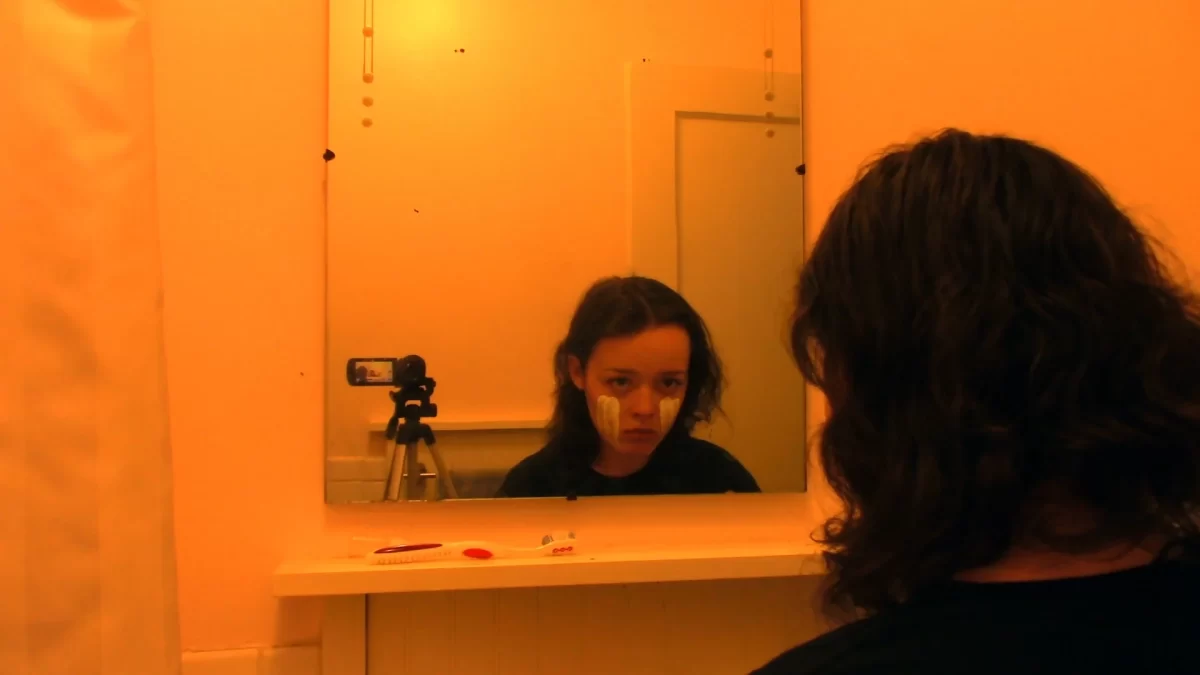
We next experience a barrage of new videos from Casey. One, titled “losing control of myself,” showcases Casey singing over a techno-pop song, emitting a blood-curdling scream at the end. A video of a cemetery is titled “tour of my high school.” In one video, she seems to be walking home from school and casually remarks, “My father keeps a gun in the barn, thinks I don’t know it.” In another, Casey walks along her town’s main street on New Years Eve and threatens to shoot her father in the stomach. Or maybe she’ll kill herself. She ends with, “Why won’t you help me?” just as she reaches the town center for a celebratory New Years countdown. In a final video, she smears herself with a white paste and records a video where she destroys Poe, whom she’s had since infancy. The black light illuminates the paste, transforming her into a glowing alien being. She flips on the lights, seems to revert back to herself, and mourns the loss of Poe.
JLB grows into a father figure for Casey, his empathy soon outweighing his love of the RPG. In a Skype call he expresses his concern, even admits that he almost reported her increasingly frantic videos. Casey is incredulous, furious. She cuts off all ties to him, tells him to never contact her again and labels him a pedophile. Worried about her mental state, he tries repeatedly to get back in touch, begs her to keep making videos so he knows she’s OK. He presses his hands to the screen.

In the end, JLB is able to take on the role of storyteller. He gives us — and his internet audience — a narrative about his visit with Casey a year later. She confesses to making it to the World’s Fair that night, but, she says, something took her back. They go their separate ways, and he stops the recording.
As JLB becomes the storyteller, he assumes the role of narrator for Casey’s story. In this narrative, their connection lost, a family pulled apart, he’s able to bridge that divide through storytelling. But what happened to Casey? Did things turn out the way JLB narrates? Why is this older man taking over the story of a teenage girl? Did she indeed experience some kind of transfiguration? Did she reach for her father’s gun? We’re not sure, but again, that’s not the point of the film. We can only speculate about Casey’s transformation, but her journey has found her on the other side of it, a place where she’s found contentment.
Schoenbrun layers World’s Fair around a structure of exploration. Our culture is in a time of major transition. Big box stores may be giving way to online shopping malls, but perhaps our identities too are shifting away from the tangible world and into the realms of the internet. We find connection online through storytelling, and through this process — and with the help of others like us — we are able to transcend our limits, transform ourselves, remake who we are, or even escape ourselves and our situations. What happens to us when we go seeking a place like the World’s Fair?
Stream We’re All Going to the World’s Fair
Purchase We’re All Going to the World’s Fair on Blu-ray from Amazon or Vinegar Syndrome
Stay up to date with all things Split Tooth Media and follow Michael on Twitter
(Split Tooth may earn a commission from purchases made through affiliate links on our site.)

